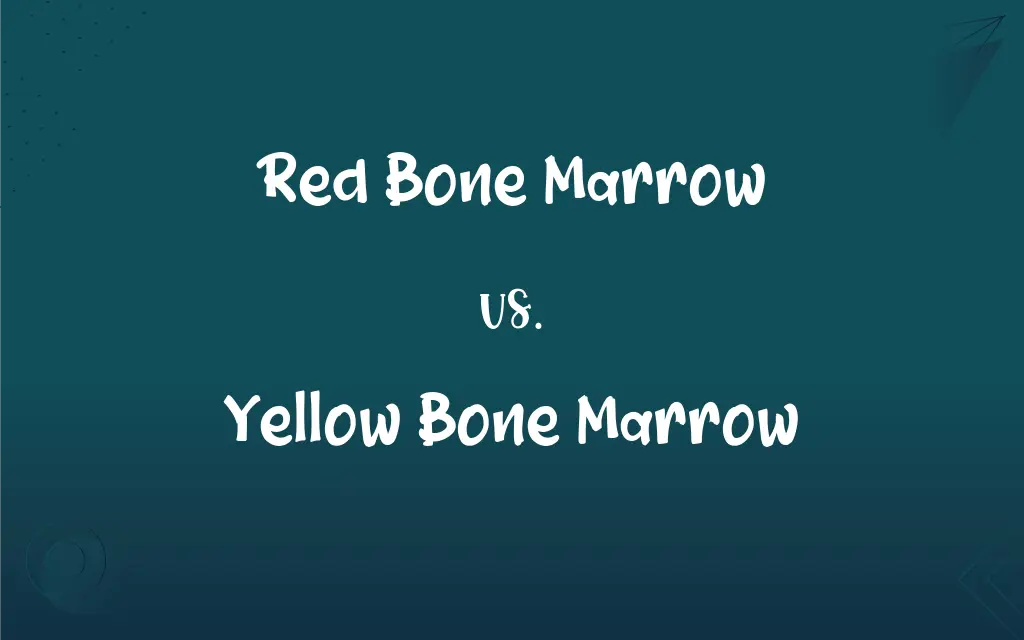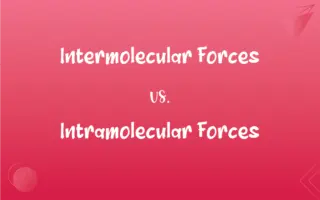Red Bone Marrow vs. Yellow Bone Marrow: What's the Difference?
Edited by Aimie Carlson || By Harlon Moss || Updated on October 27, 2023
Red bone marrow produces blood cells; yellow bone marrow stores fat.

Key Differences
Red bone marrow is rich in hematopoietic stem cells that produce blood cells. Yellow bone marrow primarily consists of adipose tissue and serves as a fat reservoir.
Red bone marrow is found in flat bones and the ends of long bones, vital for blood cell production. Yellow bone marrow is located in the central cavities of long bones, contributing to energy storage.
In children, red bone marrow is more prevalent, facilitating rapid blood cell production. In adults, some red bone marrow converts to yellow bone marrow, reducing blood cell production capacity.
Red bone marrow is essential for immune function, as it produces white blood cells. Yellow bone marrow, while not directly involved in immunity, can convert back to red marrow under certain conditions.
Red bone marrow has a dense, blood-rich composition, reflecting its active role in hematopoiesis. Yellow bone marrow has a softer, fatty composition, indicating its primary function as an energy reserve.
ADVERTISEMENT
Comparison Chart
Primary Function
Produces blood cells
Stores fat
Location
Flat bones, ends of long bones
Central cavities of long bones
Prevalence in Age
More prevalent in children
Increases with age
Role in Immunity
Essential for immune function
Converts to red marrow under certain conditions
Composition
Dense, blood-rich
Softer, fatty
ADVERTISEMENT
Color and Appearance
Reddish due to blood cell production
Yellowish due to fat content
Flexibility in Function
Fixed role in blood cell production
Can convert to red marrow in response to demands
Clinical Relevance
Assessed in bone marrow biopsies for various conditions
Less commonly assessed clinically
Energy Role
Limited role in energy storage
Major role in energy storage
Response to Anemia
Increases production of red blood cells
Can convert to red to aid in blood cell production
Red Bone Marrow and Yellow Bone Marrow Definitions
Red Bone Marrow
Found in flat and long bones.
The doctor examined the red bone marrow in the patient's hip bone.
Yellow Bone Marrow
Located in long bone cavities.
The surgeon noted the presence of yellow bone marrow in the central cavity.
Red Bone Marrow
A source of immune cells.
The red bone marrow contributes to the body's defense by producing white blood cells.
Yellow Bone Marrow
A tissue storing fat.
Yellow bone marrow in the femur serves as an energy reserve.
Red Bone Marrow
Essential for hematopoiesis.
Red bone marrow actively produces red blood cells in response to anemia.
Yellow Bone Marrow
Increases with age.
The patient's yellow bone marrow has increased as they've aged.
Red Bone Marrow
A tissue producing blood cells.
The red bone marrow is responsible for the patient's healthy blood cell count.
Yellow Bone Marrow
Can convert to red marrow.
In cases of severe anemia, yellow bone marrow can revert to red.
Red Bone Marrow
Rich in stem cells.
Stem cells in the red bone marrow are crucial for ongoing blood cell production.
Yellow Bone Marrow
Less involved in blood cell production.
Yellow bone marrow doesn't actively contribute to hematopoiesis under normal conditions.
FAQs
What is yellow bone marrow?
A tissue that stores fat.
What is red bone marrow?
A tissue that produces blood cells.
What is the main function of yellow bone marrow?
Energy storage as fat.
Where is red bone marrow found?
In flat bones and ends of long bones.
Where is yellow bone marrow found?
In the central cavities of long bones.
Does red bone marrow store fat?
It has limited fat storage capability.
What color is red bone marrow?
It's reddish due to blood cell production.
Can red bone marrow convert to yellow marrow?
Yes, with age some red marrow converts to yellow.
How does yellow bone marrow respond to anemia?
It can convert to red marrow to increase blood cell production.
Can yellow bone marrow produce blood cells?
It can convert to red marrow under certain conditions.
Is red bone marrow more common in children or adults?
More common in children.
What color is yellow bone marrow?
It's yellowish due to fat content.
Does yellow bone marrow play a role in immunity?
Not directly, but it can convert to red marrow.
Is red bone marrow involved in energy production?
Its primary role is not energy production.
Is yellow bone marrow important for hematopoiesis?
Not under normal conditions.
Can red bone marrow become yellow marrow?
Yes, it can convert with age.
How do red and yellow bone marrow respond to high altitude?
Red bone marrow may increase red blood cell production.
Are both types of marrow essential?
Yes, both play crucial roles in the body.
What cells does red bone marrow produce?
Red and white blood cells, and platelets.
What happens to red bone marrow as we age?
Some of it converts to yellow bone marrow.
About Author
Written by
Harlon MossHarlon is a seasoned quality moderator and accomplished content writer for Difference Wiki. An alumnus of the prestigious University of California, he earned his degree in Computer Science. Leveraging his academic background, Harlon brings a meticulous and informed perspective to his work, ensuring content accuracy and excellence.
Edited by
Aimie CarlsonAimie Carlson, holding a master's degree in English literature, is a fervent English language enthusiast. She lends her writing talents to Difference Wiki, a prominent website that specializes in comparisons, offering readers insightful analyses that both captivate and inform.































































